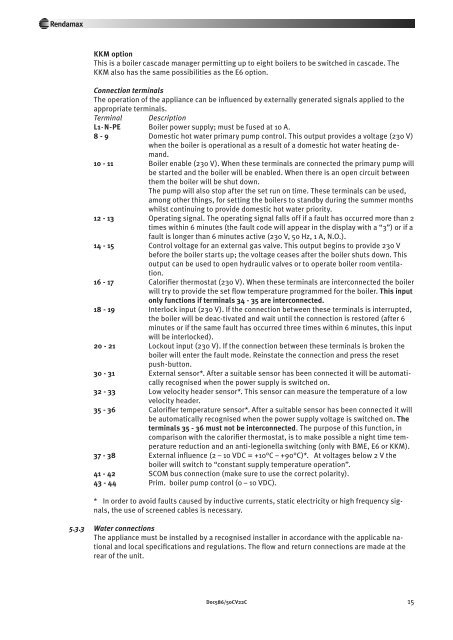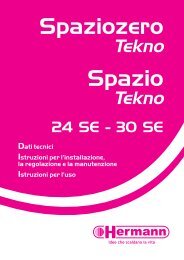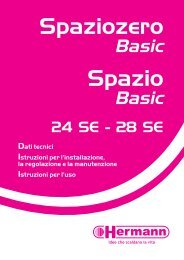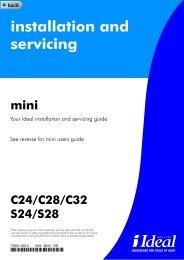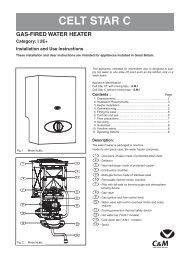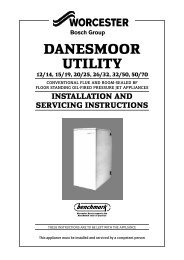sy24inst2 - The Initiative Group
sy24inst2 - The Initiative Group
sy24inst2 - The Initiative Group
Create successful ePaper yourself
Turn your PDF publications into a flip-book with our unique Google optimized e-Paper software.
Rendamax<br />
KKM option<br />
This is a boiler cascade manager permitting up to eight boilers to be switched in cascade. <strong>The</strong><br />
KKM also has the same possibilities as the E6 option.<br />
Connection terminals<br />
<strong>The</strong> operation of the appliance can be influenced by externally generated signals applied to the<br />
appropriate terminals.<br />
Terminal Description<br />
L1-N-PE Boiler power supply; must be fused at 10 A.<br />
8 - 9 Domestic hot water primary pump control. This output provides a voltage (230 V)<br />
when the boiler is operational as a result of a domestic hot water heating demand.<br />
10 - 11 Boiler enable (230 V). When these terminals are connected the primary pump will<br />
be started and the boiler will be enabled. When there is an open circuit between<br />
them the boiler will be shut down.<br />
<strong>The</strong> pump will als o s top after the s et run on time. <strong>The</strong>s e terminals can be us ed,<br />
among other things, for setting the boilers to standby during the summer months<br />
whilst continuing to provide domestic hot water priority.<br />
12 - 13 Operating signal. <strong>The</strong> operating signal falls off if a fault has occurred more than 2<br />
times within 6 minutes (the fault code will appear in the display with a “3”) or if a<br />
fault is longer than 6 minutes active (230 V, 50 Hz, 1 A, N.O.).<br />
14 - 15 Control voltage for an external gas valve. This output begins to provide 230 V<br />
before the boiler starts up; the voltage ceases after the boiler shuts down. This<br />
output can be used to open hydraulic valves or to operate boiler room ventilation.<br />
16 - 17 Calorifier thermostat (230 V). When these terminals are interconnected the boiler<br />
will try to provide the set flow temperature programmed for the boiler. This input<br />
only functions if terminals 34 - 35 are interconnected.<br />
18 - 19 Interlock input (230 V). If the connection between these terminals is interrupted,<br />
the boiler will be deac-tivated and wait until the connection is restored (after 6<br />
minutes or if the same fault has occurred three times within 6 minutes, this input<br />
will be interlocked).<br />
20 - 21 Lockout input (230 V). If the connection between these terminals is broken the<br />
boiler will enter the fault mode. Reinstate the connection and press the reset<br />
push-button.<br />
30 - 31 External sensor*. After a suitable sensor has been connected it will be automatically<br />
recognised when the power supply is switched on.<br />
32 - 33 Low velocity header sensor*. This sensor can measure the temperature of a low<br />
velocity header.<br />
35 - 36 Calorifier temperature sensor*. After a suitable sensor has been connected it will<br />
be automatically recognised when the power supply voltage is switched on. <strong>The</strong><br />
terminals 35 - 36 must not be interconnected. <strong>The</strong> purpose of this function, in<br />
comparison with the calorifier thermostat, is to make possible a night time temperature<br />
reduction and an anti-legionel la switching (only with BME, E6 or KKM).<br />
37 - 38 External influence (2 – 10 VDC = +10°C – +90°C)*. At voltages below 2 V the<br />
boiler will switch to “constant supply temperature operation”.<br />
41 - 42 SCOM bus connection (make sure to use the correct polarity).<br />
43 - 44 Prim. boiler pump control (0 – 10 VDC).<br />
* In order to avoid faults caused by inductive currents, static electricity or high frequency signals,<br />
the use of screened cables is necessary.<br />
5.3.3 Water connections<br />
<strong>The</strong> appliance must be installed by a recognised installer in accordance with the applicable national<br />
and local specifications and regulations. <strong>The</strong> flow and return connections are made at the<br />
rear of the unit.<br />
Doc586/50CV22C 15


